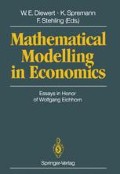Abstract
This paper considers explicit representations for very general (discrete and continuous-time) intertemporal consumption-maximization models which allow the instantaneous preferences of the consumer and the time-preference factors to vary over time and for the the non-existence of utility functions, more than one generation of consumers with a given probability of death, many commodities, and, further, a wide class of preferences which do not necessarily satisfy the so-called “regularity conditions” (such as differentiability, strict convexity, boundedness, or continuity) and include most of the well-known preferences in the literature.
We thank M. R. Baye and G. Lozada for useful comments and suggestions.
Preview
Unable to display preview. Download preview PDF.
References
Arrow, K. J. and Hurwicz, L. (1958), “On the Stability of the Competitive Equilibrium, I,” Econometrica 26, 522–552.
Blanchard, O. J. (1985), “Debt, Deficits, and Finite Horizons,” Journal of Political Economy 93, 223–247.
Blundell, R. and Walker, I. (1986), “A Life-Cycle Consistent Empirical Model of Family Labor Supply Using Cross-Section Data,” Review of Economic Studies 53, 539–558.
Brown, M. and Heien, D. M. (1972), “The S-Branch Utility Tree: A Generalization of the Linear Expenditure System,” Econometrica 40, 737–747.
Chipman, J. S. and Moore, J. C. (1976), “The Scope of Consumer’s Surplus Arguments,” in A. M. Tang et al., eds., Evolution, Welfare and Time in Economics, D. C. Heath, Lexington, Mass., 69–123.
Chipman, J. S. and Moore, J. C. (1980), “Compensating Variation, Consumer’s Surplus, and Welfare,” American Economic Review 70, 933–949.
Chipman, J. S. and Moore, J. C. (1990), “Acceptable Indicators of Welfare Change, Consumer’s Surplus Analysis, and the Gorman Polar Form,” in J. S. Chipman, D. McFadden, and M. K. Richter, eds., Preferences, Uncertainty and Optimality, Westview Press, Boulder, Colorado, 68–120.
Chipman, J. S. and Tian, G. (1992), “A General-Equilibrium Intertemporal Model of an Open Economy,” Economic Theory 2, 215–246.
Cooper, R. J. and Mclaren, K. R. (1983), “Modelling Price Expectations in Intertemporal Consumer Demand Systems: Theory and Application,” Review of Economics and Statistics 65, 282–288.
Gorman, W. M. (1976), “Tricks with Utility Functions,” in M. Artis and R. Nobay, eds., Essays in Economic Analysis, Cambridge University Press, Cambridge, 211–243.
Kantorovich, L. V. (1965), The Best Uses of Economic Resources. Harvard University Press, Cambridge, Mass.
Leontief, W. W. (1956), “Factor Proportions and the Structure of American Trade: Further Theoretical and Empirical Analysis,” Review of Economics and Statistics 38, 386–407.
Levhari, D. and Srinivasan, T. N. (1969), “Optimal Savings Under Uncertainty,” Review of Economic Studies 36, 153–163.
Lluch, C. (1973), “The Extended Linear Expenditure System,” European Economic Review 15, 21–32.
Macurdy, T. E. (1983), “A Simple Scheme for Estimating an Intertemporal Model of Labor Supply and Consumption in the Presence of Taxes and Uncertainty,” International Economic Review 24, 265–289.
Sargent, T. J. (1987), Dynamic Macroeconomic Theory, Harvard University Press, Cambridge, Mass., 1987.
Tian, G. and Chipman, J. S. (1989), “A Class of Dynamic Demand Systems,” in B. Raj, ed., Advances in Econometrics and Modeling, D. Reidel Publishing Company, Dordrecht, Holland, 93–116.
Yaari, M. E. (1965), “Uncertain Lifetime, Life Insurance, and Theory of the Consumer,” Review of Economic Studies 32, 137–50.
Author information
Authors and Affiliations
Editor information
Editors and Affiliations
Rights and permissions
Copyright information
© 1993 Springer-Verlag Berlin · Heidelberg
About this chapter
Cite this chapter
Chipman, J.S., Tian, G. (1993). Closed-Form Solutions of General Intertemporal Consumption-Maximization Models. In: Diewert, W.E., Spremann, K., Stehling, F. (eds) Mathematical Modelling in Economics. Springer, Berlin, Heidelberg. https://doi.org/10.1007/978-3-642-78508-5_10
Download citation
DOI: https://doi.org/10.1007/978-3-642-78508-5_10
Publisher Name: Springer, Berlin, Heidelberg
Print ISBN: 978-3-642-78510-8
Online ISBN: 978-3-642-78508-5
eBook Packages: Springer Book Archive

